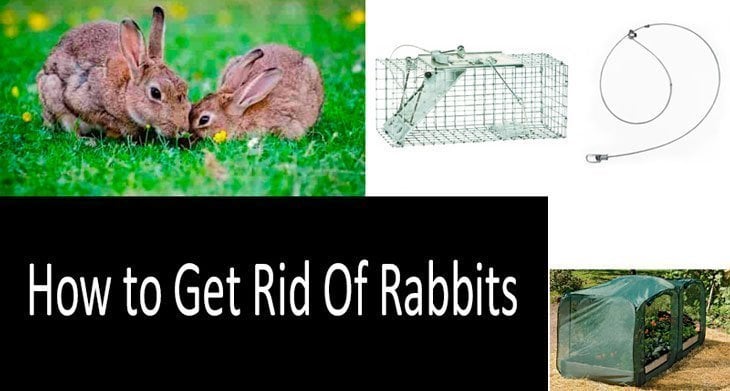A bunny is one of the cutest and most amusing creatures ever. That is, if you encounter them online, of course, as watching funny videos and pictures with these fluffy balls is a real pleasure.
Meeting this cutie in real life is a whole different story, though. The rabbits become a true problem for farmers and gardeners, for those who live in small villages or even in big cities. Here’s why it is an issue:
- The rabbits are almost omnivorous.
- They breed extremely fast.
- They are not that easy to scare and repel from your place.
We’ll teach you this complicating science of getting rid of rabbits, tell you about the delicate balance of using fence, traditional methods and artificial chemical repellents. But first, let’s take a closer look at a rabbit, the enemy of all gardeners and farmers!
10 Steps On How To Get Rid Of Rabbits
If you want to keep rabbits out of your garden or backyard, you should craft a detailed plan. Below you will find some helpful tips on which steps your plan should include.
- If rabbits have frequented your garden, modify the habitat. These animals do not feel safe in open spaces, therefore, they need dense vegetation to feel comfortable in the area. Trim shrubs and cut tall grass, as well as remove piles of branches so that rabbits do not have a shelter to hide. This will make your garden less attractive to them.
- Erect fences as physical barriers preventing rabbits from entering your property. This is especially effective in the summer while in the winter, the fence should be high enough, otherwise, rabbits will jump over it using snowbanks. Place netting on vegetable beds, shrubs, and fruit crops to protect them from being chewed by rabbits.
- Since rabbits are very sensitive to strong odors, apply repellents to plants in the garden. Repellents can be homemade or ready-to-use purchased from a store. Solutions containing ammonia, pepper, and human hair, work through the sense of odor while products with such active ingredients as thiram affect the sense of taste.
- Use frightening electronic devices to scare rabbits out of the garden. These primarily include motion-activated sprinklers and ultrasonic devices. Change their location regularly so that rabbits do not habituate to these techniques.
- Implement the carrot and stick approach. While frightening rabbits from your precious crops, provide them with an alternative source of food. Install feeders outside your property to let them satisfy hunger and discourage from making their way to the garden. The downside of this humane method is that it is likely to attract other animals.
- Exploit natural enemies of rabbits. Not only does it include dogs and cats but birds like owls and hawks as well.
- In case all mentioned above does not work, trap these unwanted visitors. Traps capturing rabbits alive are humane but labor-consuming. You have to lure the animal inside the cage with a bait and then release three miles away from your house.
- Lethal traps of a Conibear type or snares are also available. And yet, traps are not effective if the rabbit population in the area is high. Poisoning of rabbits is illegal and there are no poisons registered for these animals. Moreover, you risk killing non-target animals and attracting predators such as coyotes which prey on the dead as well.
- You can kill rabbits by shooting but previously check your local legislation to make sure that it is legal in your state. This is a quick and easy solution.
- If rabbits have literary invaded your property, perhaps the only way of getting rid of them is calling professional exterminators. it is the most expensive but effective measure.
For more information about how to make things right, why you should take a different approach depending on the season and what methods are recommended to keep rabbits out of the garden, read a detailed guide below. We have also picked the most popular and useful products on to help you solve the problem.
9 Rabbits Facts Useful for Eliminating Them Effectively
Most often the rabbits appear within the “human habitat” at night or in the winter, when we pay less attention to our gardens and orchards. That’s why few people manage to observe the behavior of this animal. We’ll make the task easy for you. Here are 9 crucial facts about the behavior of most rabbit species which you need to know about.
- They love eating. Their diet includes grass and shrubs, willows and oaks, forest and garden berries, parsley and even coriander. As for vegetables, they prefer broccoli, beets, beans and carrots, peas and lettuce. A rabbit will surely try almond, apple, cherry, plum, pistachio, strawberry and raspberry, if it will be able to reach them. Some of them even consume fir-needles.
- A single tiny rabbit can destroy a dozen large trees. Rabbits love chewing on fresh bark, especially in winter. Along with the bark, they also consume the upper layer wood fiber, which is deadly even for any grown tree. The Iowa State University experts assure that minor damage from a couple of rabbit raids is treatable, while the rabbits’ stable feeding on the bark can make the damage to the tree irreversible.

- They damage your property. Farmers’ threads online contain lots of complaints of rabbits destroying decorations in the gardens or even some PVC pipes. In some cases these pests are able to break down the entire irrigation to such an extent that the owners have to replace the damaged pipe.
- They breed very fast. The rabbit breeding season begins in December and ends in June. The average litter size is 3-4 kittens. A female rabbit can get pregnant 6 times in a year, according to the University of California IPM experts. This adds up to the fact that a single rabbit near your garden can spawn 20-30 more animals within a year.
- They leave waste. The experts recommend tracing a rabbit through its feces and peculiar teeth marks left on the bark. While the deer tend to rip it off, the rabbits grind it with their sharp incisors downwards at an angle of 45 degrees. These long-eared creatures cut the branches very accurately, as if they do with a knife. In winter they also leave peculiar trails on snow.
- Rabbits are not social animals. They can coexist, but they rarely arrange mass raids. As a rule, a territory of 10-15 acres is enough for a single rabbit, and it will barely visit other rabbits. By the way, some experienced hunters claim that if you catch a rabbit and take it 3 miles away from home, it won’t make its way back.
- Rabbits react to smells and tastes, hence the popularity of traditional and artificial chemical repellents. Judging by the Cornell Cooperative Extension research, garlic, onion and marigold are considered to be the rabbits’ natural enemies.
- Rabbits love hiding away. Rabbits barely inhabit any open plains. They need to have some reliable shelter, like shrubs or high grass. Rabbits also know how to hide behind garbage piles, garden sheds and other farming buildings.

- Rabbits don’t like jumping. Despite all the myths, these animals only jump high when in extreme danger, for example, when trying to escape from a fox or a dog. Even a low fence of 2 ft will be a serious obstacle for them.
How to Get Rid Of Rabbits in the Summer
Each season is characterized by having its own peculiarities to be taken into account when eliminating these dangerous animals. Things are pretty simple in the summer unless it’s raining. All of the existing rabbit elimination methods can be used during this season. We’ll classify them as either lethal (which kill the pest) and non-lethal. Let’s start with more humane ones.
- Fence the whole area. Even a low fence will save you from rabbits in summer. In winter the animals can use snow drifts as trampolines, but when it’s hot they won’t be able to even overcome a 2-3 feet high obstacle. You don’t have to make it solid, as a net with the cells smaller than an inch will do. By the way, rabbits are good at digging, so make sure the fence is deep in the ground.
- Fence certain plants, shrubs and flower beds. The idea is simple here. Use a border or a net around the shrubs, herbs and berries, and wrap the trees with aluminum foil or some other protective cover. University of California IPM, in its turn, recommends the following:
Poultry netting with a 1-inch mesh and that is 18 to 24 inches wide is ideal for cutting into strips 18 to 20 inches long and forming into cylinders for placement around the trunks of young trees, shrubs, or vines. Bury the bottom of the cylinders 2 to 3 inches, and brace them away from the trunk, so rabbits can’t press against the cylinder and nibble through the mesh. Inspect these barriers regularly, and be sure to keep the area inside the barriers clean of leaves, weeds, and other debris to eliminate feeding sites for small rodents. Commercial tree trunk protectors also are available.
You can also use ready-to-use fences, such as Pest Control Pop Up which come in different shapes and sizes, and cost Check current price This is a sort of a tent for your garden plants which is easy to install and to remove when necessary. The netting will provide for proper air circulation and won’t let the rabbits spoil your crops or flowers.
- Use repellents. There are two types of repellents: organic and artificial ones. We’ll cover both best homemade and ready-to-use repellents with comments from the scientists in our Best Rabbit Repellents Review. Read it, there are many interesting things mentioned!
- Use humane traps. Only lethal traps, such as mantraps are considered effective. Humane traps require too much fuss, such as installing it, finding bait, getting the victim 3 miles away from your house… Nevertheless, many states outlaw such traps, as you will basically drop a pest on your neighbors’ premises. Moreover, direct contact with a rabbit can make you catch some nasty disease. However, if you are ready to take the caught rabbits somewhere in the woods, pay attention to Havahart traps, such as Havahart 1083 Easy Set One-Door Cage Trap for Squirrels and Small Rabbits for Check current price. This manufacturer specializes in designing humane traps for different animals, including rabbits.
Other measures can be used in order to decrease the rodent population more intensely. For example, hold a cleaning day in the neighborhood and make sure you clean all the spots where the animals can hide. Getting a dog is also a good idea, although the rabbits are not that scared of barking chained dogs. Hunter dogs, on the other hand, fit into the lethal section which we’ll elaborate on below with less pleasure.
- Use lethal traps. Rabbits will never stop munching on trees, even if they will have carrots or fresh herbs available. That’s what is handy for the fans of bloody traps. Rabbits fall for such traps easily, and your job is to dispose of the dead body and make sure you didn’t get contaminated by it.
Here is a trap recipe by University of California IPM: “you can trap cottontails and brush rabbits with a Conibear trap (No. 110), which kills the animal outright. Place the trap inside a covered box constructed from 3/4-inch exterior plywood with a 4-inch wide entrance. To further reduce hazards to children, pets, and poultry, position the trap back from the entrance. Slots at the back end of the box help in positioning the trap as does the hinged lid. The hole cut in the top of the hinged portion and covered with 1/4-inch mesh hardware cloth serves as a means to check the trap or bait. Other kill-type traps, such as a tunnel trap, are also available”.
As an alternative, you can use 1 Dz Dakotaline Rabbit Snares trap for Check current price, which is designed especially for catching the rabbits. It looks like a wired loop-wire which strangles the rodent’s neck and deprives it of oxygen. This trap has to be well-hidden in the grass in order for a rabbit to get caught on such bait. Don’t touch it unless you’re wearing gloves, as the rabbits can identify human odor easily.
- Use poisons. Scientists don’t advise using poisons as this is not the coolest method which can bring you a lot of trouble. The dead rabbit bodies, for example, can attract predators and the poison itself is harmful for pets. In addition, we weren’t able to find on the market any more or less good poisons designed especially for the rabbits.
- Try shooting and hunting. Hunting rabbits is officially permitted in most regions. The drawback is that this elimination method requires much hassle and investment, although it does effectively strike the entire rabbit population and lets you even have certain fun in process.
How to Get Rid Of Rabbits in the Winter
We can’t say that when winter comes, the conditions and rules of getting rid of rabbits change entirely. Nevertheless, some seasonal changes still occur.
First of all, rabbits’ natural food reserves are substantially reduced in winter. That’s why they draw closer to human accommodation and are no longer afraid of external stimuli. Second, snow comes to their advantage, as it washes off poison and helps overcome artificial obstacles. Don’t worry, though, as some useful knowledge will help you!
- Use repellents. Most of these products are less effective in winter. They get dissolved in snow and rain, get covered with snow, freeze under ice and stop working. That’s why you should be very careful when it comes to picking artificial chemicals for winter. Read our Best Rabbit Repellents Review to find out which repellents are best-suited for winter.
- Fence the entire territory and certain plants. This measure is still effective in winter. You have to bear in mind the golden rule that all of the fences should be enlarged proportionately to the size of a possible snowdrift nearby.
- Use mantraps and shoot. The brutal part of our guide does not change generally. The main idea is not to leave the victims rotting where you’ve killed them, so that no hungry predators are attracted to your house.

Moreover, remember that in winter the rabbits’ appetite is focused on young trees. Ensure their safety first and make sure there are no huge snowdrifts, bumps or brushwood piles on the territory.
How to Keep the Rabbits Out Of Your Garden
- Use water! If you have an automatic lawn irrigation system, set it properly. You need your optical sensor to react to movement detected and to shower the said spot. Powerful water jets will surely repel a rodent! If you like this method of repelling the rabbits, but you don’t have a sprinkler yet, don’t waste time looking for it and read our review of the Best Motion-Activated Sprinklers.
- Don’t let the rabbits drink this water. The water can not only repel, but also attract the rabbits. A small pool, a lake or a decorative pond on your territory will become very attractive for animals. They can get to it to drink some water, so don’t forget to enclose such areas with fences and borders.
- Use professional help. If you’re afraid that the rabbit infestation will turn into a real siege of your place and you can’t bring yourself to murder these cutie pies, call the exterminators.
- Feed them! Gardeners have offered the kindest and most contradictory control method. They recommend installing rabbit feeders on your property. The animals will consume whatever is in the feeders and won’t damage your place. Still, such kindness can attract more animals than you can feed in some cases.








